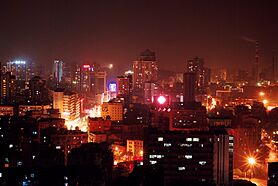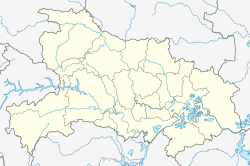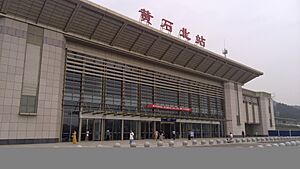Huangshi facts for kids
Quick facts for kids
Huangshi
黄石市
Hwangshih
|
|
|---|---|
|
Prefecture-level city
|
|
|
From top, left to right: Downtown Huangshigang; Huangshibei Railway Station; Huangshi Yangtze River Bridge; Ci Lake in Winter; Po Lin Monastery, Yangxin County
|
|
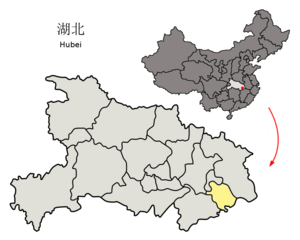
Location of Huangshi City jurisdiction in Hubei
|
|
| Country | People's Republic of China |
| Province | Hubei |
| Municipal seat | Xialu District |
| Area | |
| • Prefecture-level city | 4,582.85 km2 (1,769.45 sq mi) |
| • Urban | 233.80 km2 (90.27 sq mi) |
| • Metro | 1,800.1 km2 (695.0 sq mi) |
| Population
(2020 census)
|
|
| • Prefecture-level city | 2,469,079 |
| • Density | 538.7650/km2 (1,395.3948/sq mi) |
| • Urban | 695,894 |
| • Urban density | 2,976.45/km2 (7,708.97/sq mi) |
| • Metro | 1,567,108 |
| • Metro density | 870.567/km2 (2,254.76/sq mi) |
| GDP | |
| • Prefecture-level city | CN¥ 122.8 billion US$ 19.7 billion |
| • Per capita | CN¥ 50,053 US$ 8,036 |
| Time zone | UTC+8 (China Standard) |
| ISO 3166 code | CN-HB-02 |
| Licence plate prefixes | 鄂B |
| Website | (in Simplified Chinese) |
Huangshi (simplified Chinese: 黄石; traditional Chinese: 黃石; pinyin: Huángshí) is a large city in southeastern Hubei province, China. It is also known as Hwangshih. In 2020, about 2.4 million people lived in Huangshi. More than 1.5 million of them lived in the main city area.
Contents
Discover the History of Huangshi
Early Beginnings of Huangshi
The history of Huangshi goes back a long time. Around 845 BC, a leader named Marquis Wen Huang Meng moved the capital of the State of Huang to Huangchuan. His family ruled this state until 648 BC. At that time, another state called Chu took over.
The people of Huang then moved to the area we now call Hubei province. They settled in a region known as Jiangxia Prefecture during the Han dynasty (206 BC-AD 220).
Huangshi During World War II
During World War II, on March 9, 1944, American and Chinese planes flew over Huangshi. They bombed a metal factory and docks. Japanese fighter planes tried to stop them, and two American P-40 planes were lost.
Explore the Geography of Huangshi
Huangshi is located in southeastern Hubei province. It sits mostly along the southwestern side of a big bend in the Yangtze River. The city is about 100 kilometers (62 miles) southeast of Wuhan. It also shares a border with Jiangxi province to the south.
The total area of Huangshi is about 4,583 square kilometers (1,770 square miles). The land is mostly made up of small mountains and hills. The highest point is 7 Summit Mountain, which is 860 meters (2,820 feet) above sea level. Huangshi is also known for its many lakes. It is located in a major lake area between Hunan's Dongting Lake and Jiangxi's Poyang Lake.
Huangshi's Climate and Weather
Huangshi has a mild, sub-temperate climate. The average temperature each year is about 17°C (63°F). The city gets about 1,400 millimeters (55 inches) of rain every year. There are usually 264 days without frost. Sometimes, you might see a little snow between December and February.
| Climate data for Huangshi (1991–2020 normals) | |||||||||||||
|---|---|---|---|---|---|---|---|---|---|---|---|---|---|
| Month | Jan | Feb | Mar | Apr | May | Jun | Jul | Aug | Sep | Oct | Nov | Dec | Year |
| Mean daily maximum °C (°F) | 8.6 (47.5) |
11.6 (52.9) |
16.2 (61.2) |
22.7 (72.9) |
27.4 (81.3) |
30.3 (86.5) |
33.5 (92.3) |
33.1 (91.6) |
29.2 (84.6) |
23.7 (74.7) |
17.4 (63.3) |
11.2 (52.2) |
22.1 (71.8) |
| Daily mean °C (°F) | 4.8 (40.6) |
7.5 (45.5) |
11.9 (53.4) |
18.0 (64.4) |
22.9 (73.2) |
26.2 (79.2) |
29.4 (84.9) |
28.8 (83.8) |
24.8 (76.6) |
19.0 (66.2) |
12.7 (54.9) |
6.9 (44.4) |
17.7 (63.9) |
| Mean daily minimum °C (°F) | 2.1 (35.8) |
4.5 (40.1) |
8.4 (47.1) |
14.1 (57.4) |
19.0 (66.2) |
22.9 (73.2) |
25.9 (78.6) |
25.4 (77.7) |
21.4 (70.5) |
15.5 (59.9) |
9.4 (48.9) |
3.8 (38.8) |
14.4 (57.8) |
| Average precipitation mm (inches) | 66.9 (2.63) |
82.6 (3.25) |
118.3 (4.66) |
163.2 (6.43) |
174.3 (6.86) |
239.7 (9.44) |
235.4 (9.27) |
141.0 (5.55) |
78.2 (3.08) |
68.8 (2.71) |
63.4 (2.50) |
40.0 (1.57) |
1,471.8 (57.95) |
| Average precipitation days (≥ 0.1 mm) | 11.1 | 11.9 | 14.3 | 13.3 | 13.2 | 13.9 | 13.2 | 11.6 | 7.8 | 9.2 | 9.2 | 8.4 | 137.1 |
| Average snowy days | 3.8 | 2.1 | 0.5 | 0 | 0 | 0 | 0 | 0 | 0 | 0 | 0.2 | 1.1 | 7.7 |
| Average relative humidity (%) | 78 | 77 | 76 | 74 | 75 | 79 | 77 | 77 | 75 | 75 | 77 | 75 | 76 |
| Mean monthly sunshine hours | 81.1 | 86.1 | 111.1 | 141.4 | 152.3 | 138.9 | 192.3 | 195.2 | 157.3 | 144.4 | 120.4 | 109.6 | 1,630.1 |
| Percent possible sunshine | 25 | 27 | 30 | 36 | 36 | 33 | 45 | 48 | 43 | 41 | 38 | 35 | 36 |
| Source: China Meteorological Administration | |||||||||||||
How Huangshi is Governed
As of 2016, Huangshi is divided into different areas for local government. It has 4 districts, 1 county, and 1 county-level city. These divisions help manage the city and its surrounding areas.
| NBS Area No. | Name (from Mand.) | Chinese (Simp.) | ||||
|---|---|---|---|---|---|---|
| 420201000000 | city-administered area | 市辖区 | ||||
| Districts | ||||||
| 420202000000 | Huangshigang District | 黄石港区 | ||||
| 420203000000 | Xisaishan District | 西塞山区 | ||||
| 420204000000 | Xialu District | 下陆区 | ||||
| 420205000000 | Tieshan District | 铁山区 | ||||
| former | Shihuiyao District | 石灰窑区 | ||||
| County | ||||||
| 420222000000 | Yangxin County | 阳新县 | ||||
| County-level City | ||||||
| 420281000000 | Daye | 大冶市 | ||||
| Other Areas | ||||||
| - | Huangshi Economic Technology Development District | 黄石经济技术开发区 | ||||
| Map |
|---|
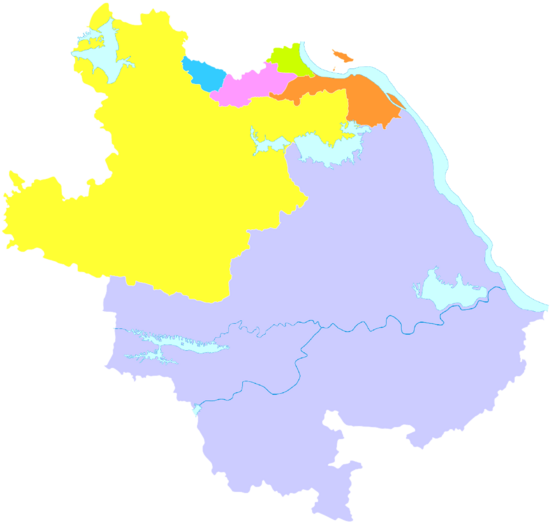
1
Xisaishan
Xialu
Tieshan
Yangxin
County Daye
(city) 1.Huangshigang
|
People Living in Huangshi
In 2000, a census showed that Huangshi had about 2,476,400 people. This means there were about 540 people living in each square kilometer. Most of the people, over 99%, are from the Han ethnic group.
The main city area of Huangshi is quite crowded. For example, Huangshigang District has about 196,600 people. This area has a population density of 5,757 people per square kilometer.
Huangshi's Economy and Industries
Huangshi is an important center for business and transportation. It is close to Wuhan and located along major train lines and the Yangtze River. This makes it a good place for moving goods and people.
Rich Mineral Resources
Huangshi is famous for its many mineral resources. It is sometimes called "The Southern Cornucopia" because of this. You can find metals like iron, manganese, gold, copper, and zinc here. There are also other important minerals such as germanium and sulfur.
Farming and Other Industries
Farming is also a big part of Huangshi's economy. The area has over 3,000 types of plants. Many of these plants are used for food, medicines, and perfumes.
Other important industries in Huangshi include making metals, textiles (fabrics), and building materials. The city also produces energy, light manufactured goods, electronics, medicines, and chemicals. Food processing is another key industry.
Two of the largest companies in Huangshi are Daye Steel Co. Ltd and Huaxin Cement Co. Ltd.
Getting Around Huangshi: Transportation
Huangshi has good transportation links. Major highways like G45 Daqing–Guangzhou Expressway and G50 Shanghai–Chongqing Expressway pass through the city. There are also national highways and the Wuhan–Jiujiang Railway.
The city has two bridges that cross the Yangtze River. These are the Huangshi Yangtze River Bridge and the Edong Yangtze River Bridge.
Train Travel in Huangshi
Many passenger trains traveling between Wuhan and other cities stop at Huangshi and Yangxin stations. The Huangshi Station is about 5 kilometers (3 miles) north of downtown Daye. It is also about 10 kilometers (6 miles) west of downtown Huangshi. The Yangxin Station is close to Yangxin County's main town.
Even though the main part of Huangshi is a bit far from the main train line, it has a special branch line. This line goes all the way to Huangshi's port on the Yangtze River. This is very important for local businesses.
In 2014, a new commuter train line opened, connecting Wuhan and Huangshi. This line has three stations in the Huangshi area: Huahu, Huangshi North, and Daye North.
Fun Places to Visit in Huangshi
Huangshi is surrounded by many beautiful lakes and mountains. It's a great place to explore nature and learn about history.
- Dongfang Mountain: This mountain has a famous Buddhist Temple. It's a peaceful place to visit.
- Ci Lake: This beautiful lake is part of the larger Qingshan Lake. The Ci Lake Scenery Park is a lovely spot to relax. It separates the older parts of Huangshi from newer development areas.
- Huangshi National Mining Park: This unique park was once a large iron mine. You can see old and new mining equipment here. It's a cool place to learn about the city's mining history.
- Xisaishan: Located on the south bank of the Yangtze River, Xisaishan offers amazing views of the city and the river below. It's a popular tourist spot.
- Huaxin 1907 Cultural Park: This park is built on the site of the old Huaxin Cement Plant. This plant was one of China's first cement companies. It's now a cultural park where you can learn about its history.
Notable People from Huangshi
- Chen Shu, actress
- Cheng Fei, gymnast
- He Xiaopeng, entrepreneur
- Huang Zhe, rower
- Ke Hua, canoeist
- Ke Zhao, footballer
- Li Shanshan, gymnast
- Ling Tai, actress
- Liu Yun, footballer
- Ma Liuming, painter
- Shi Zhenglu, lieutenant general in the People's Liberation Army
- Tang Anqi, singer
- Wei Guangqing, painter
- Yin Congyao, footballer
- Yu Yangyi, Chess grandmaster
- Zhan Jian, Singaporean table tennis player
- Zhang Yongjun, basketball coach and former player
- Zhang Yuqi, singer
- Zheng Kaimu, footballer
Images for kids
See also
 In Spanish: Huangshi para niños
In Spanish: Huangshi para niños


